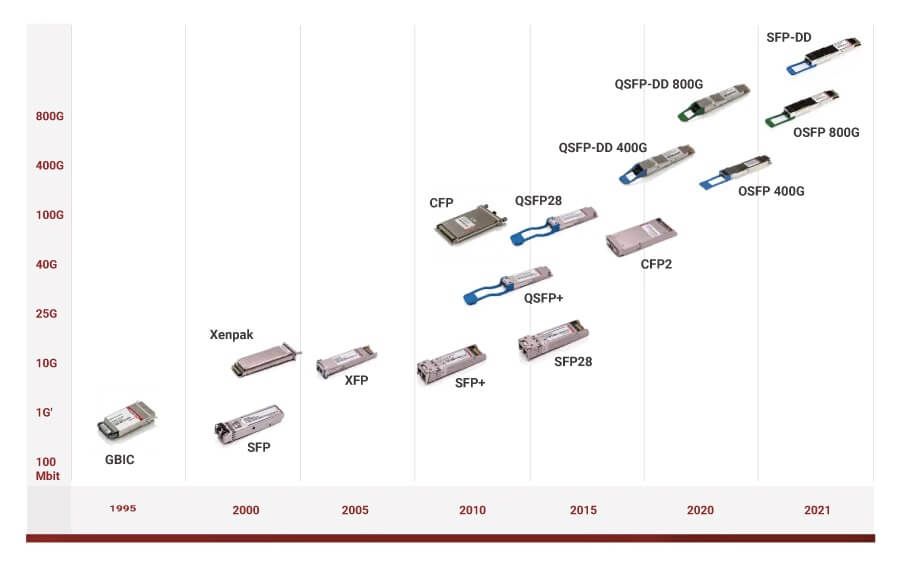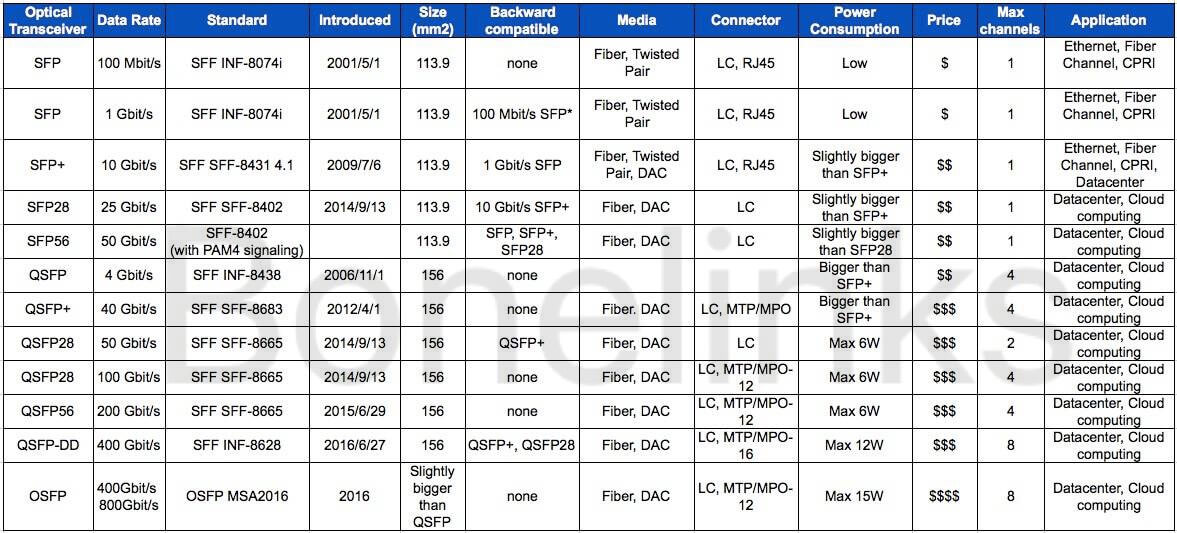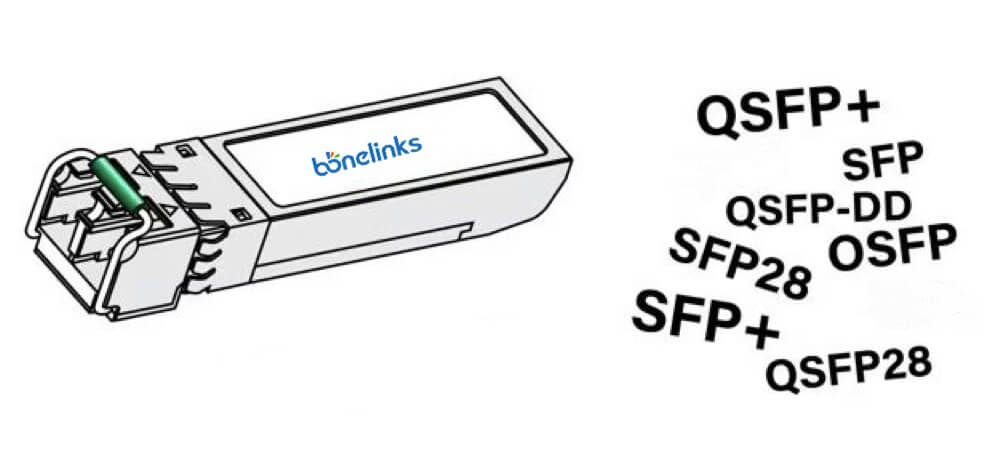Optical transceiver modules play a crucial role in modern high-speed data communication networks. These compact and easily interchangeable modules serve as interfaces between devices like network switches and routers, converting both electrical and optical signals. The diversity of optical transceivers is reflected in various connector types and form factors, including SFP, SFP+, SFP28, QSFP+, QSFP28, QSFP-DD, and OSFP. But what are the differences?
Before we delve into the details, let’s have a quick introduction to some of the essential optical transceivers that are commonly used. This will help us better understand the differences between them.

What is an SFP Transceiver?
SFP, or small form-factor pluggable, is a compact transceiver that connects fiber optic cables to devices like switches, routers, and network cards. It’s also called a “mini-GBIC” (gigabit interface converter). Different types of SFP transceivers are available based on data rates, like 155M, 622M, 1G, 2.5G, 2G/4G Fiber Channel, 3G, and 6G SFP. They’re commonly used in fiber-optic Ethernet networks, especially in commercial setups, and are widely popular in today’s networking technology.
What is an SFP+ Transceiver?
SFP+ transceivers are an upgraded version of SFP technology. They usually operate at speeds of 8Gbps, 10Gbps, or 16Gbps. Their size matches that of SFPs, making integration into existing setups easy. SFP+ transceivers are widely used in data center cabling.
There are five main types of SFP+ transceivers based on their application: Dual Fiber SFP+, BiDi SFP+, Copper SFP+, CWDM SFP+, and DWDM SFP+.
What is the SFP28 Transceiver?
SFP28, which stands for Small Form-Factor Pluggable 28, is the third generation of SFP connection systems designed for 25G data throughput based on the IEEE 802.3by specification (25GBASE-CR). SFP28 is an improved version of SFP+ tailored for 25G connections. It can transmit at a maximum rate of 28Gbps, hence the name SFP28. While maintaining the same size as SFP+, SFP28 offers 25Gbps electrical connections per channel, providing a significantly higher bandwidth compared to SFP+.
SFP28 transceivers come in six main categories based on their use: Dual Fiber SFP28, BiDi SFP28, CWDM SFP28, DWDM SFP28, SFP28 DAC, and SFP28 AOC.
What is a QSFP+ Transceiver?
QSFP+, also referred to as QSFP, stands for quad (4-channel) small form-factor pluggable. It’s a compact and hot-pluggable optical transceiver utilized for 40 Gigabit Ethernet (40GbE) data communications. Unlike SFP+, QSFP+ offers support for 4x10G or 4x14G SFP+ data rates, which enhances bandwidth capabilities. It presents various data rate choices for Ethernet, Fibre Channel, InfiniBand, and SONET/SDH technologies.
What is a QSFP28 Transceiver?
QSFP28, short for quad small form-factor pluggable 28, is designed for applications like 100 Gigabit Ethernet, EDR InfiniBand, or 32G Fibre Channel networks. The QSFP28 100G transceiver comprises four high-speed differential signal channels with data rates from 25 Gbps to 40 Gbps. Within the 100G optics sector, QSFP28 transceivers are preferred over CFP, CFP2, and CFP4 form factors.
What is a QSFP-DD Transceiver?
Quad Small Form Factor Pluggable Double Density (QSFP-DD), also known as QSFP56-DD, brings the concept of “double density” by doubling the number of high-speed electrical interfaces supported compared to a regular QSFP28 module. This is achieved by adding an extra row of contacts for an eight-lane electrical interface. Notably, all QSFP-DD-based transceivers, ranging from 40G to 200G, maintain backward compatibility with QSFP+. Remarkably efficient, a single QSFP-DD unit within a rack can accommodate 36 400GbE ports, collectively delivering an impressive bandwidth of almost 14Tb/s.
What is an OSFP Transceiver?
OSFP, which stands for Octal Small Form-factor Pluggable, is a forward-looking pluggable format that incorporates 8 electrical lanes, each operating at 50Gb/s, resulting in an impressive total bandwidth of 400Gb/s. This innovative technology redefines pluggable solutions by offering a substantial 400 Gbps capacity (through 8x50G or 4x100G channels). It’s noteworthy that a single 1U front panel can accommodate 32 OSFP ports, contributing to an overall bandwidth of 14.4 Tbps per 1U swap slot. To keep pace with the upcoming 800G optics, enhanced OSFP optics are being developed, focusing on improved signal integrity and thermal efficiency. Interestingly, OSFP can also be utilized alongside 100G QSFP optics.
SFP vs SFP+ vs SFP28 vs QSFP+ vs QSFP28 vs QSFP-DD vs OSFP, What are the Differences?
Here is the overview of the differences between optical transceivers.

(Reference: https://en.wikipedia.org/wiki/Small_Form-factor_Pluggable)
Here is a detailed comparison of various optical transceivers for your understanding.
SFP vs SFP+
In short, SFP+ is an enhanced version of SFP. These two optical transceivers come in the same physical size but vary in speed and compatibility. SFP usually supports 1.25Gbit/s to 4.25 Gbit/s, while SFP+ supports data rates up to 10Gbit/s. SFP+ is designed for 10-Gigabit Ethernet use, while SFP is suitable for 100BASE or 1000BASE applications. SFP adheres to IEEE802.3 and SFF-8472 standards, whereas SFP+ follows SFF-8431. SFP+ ports can accommodate SFP optics but at a reduced speed of 1 Gbit/s. However, an SFP+ transceiver cannot be inserted into an SFP port, as this could cause damage to the product or port. Typically, SFP+ is pricier than SFP.
SFP+ vs SFP28
SFP+ is primarily used for 10G connections, whereas SFP28 is typically used for 25G connections. Despite this speed difference, they share the same form factor, and the connectors of SFP28 and SFP+ have mating compatibility. Therefore, SFP28 can function with SFP+ optics, but the speed will be limited to 10 Gbit/s. If a network switch’s SFP28 port can be configured for 10G transmission, SFP+ modules can effectively work with it. However, if the SFP28 port cannot be set for 10G transmission, SFP+ modules won’t function properly.
SFP+ vs QSFP+
The main distinction between QSFP and SFP lies in the quad form. QSFP+ is an advancement of QSFP designed to accommodate four 10 Gbit/s channels, carrying 10-Gigabit Ethernet, 10G Fiber Channel, or InfiniBand. This enables the use of 4X10G cables and stackable networking designs, leading to improved throughput. QSFP+ has the capacity to replace 4 standard SFP+ transceivers, offering higher port density and overall cost savings compared to SFP+.
SFP28 vs QSFP28
SFP28 and QSFP28 transceivers utilize distinct sizes and operational principles. SFP28 supports a single 25 Gbit/s channel, whereas QSFP28 supports 4 independent lanes, each operating at 25 Gbit/s. While both can be used in 100G networks, SFP28 is employed in the form of a QSFP28 breakout solution to achieve this configuration.
QSFP+ vs QSFP28
Both QSFP+ and QSFP28 transceivers consist of four transmit and four receive channels within the same physical size. These products also encompass transceiver modules and DAC/AOC cables, although operating at different speeds. QSFP+ modules support 1×40 Gbit/s, while QSFP+ DAC/AOC cables work at 4×10 Gbit/s. QSFP28 modules, on the other hand, achieve 100 Gbit/s transmission, and QSFP28 DAC/AOC cables can operate at 4×25 Gbit/s or 2×50 Gbit/s. It’s important to note that QSFP28 modules typically cannot be split into 10G links. However, inserting QSFP+ modules into QSFP28 ports is a different scenario. If the switch allows it, QSFP28 can be configured to function as 4x10G, similar to QSFP+ transceiver modules.
FAQs about Different Optical Transceivers
Q: Can I use an SFP transceiver in SFP28 ports?
A: Yes, you can. SFP28 ports are backward compatible with SFP transceivers and cables. However, it’s important to note that while SFP transceivers and cables can be plugged into SFP28 ports, they won’t support the higher 25Gb/s data rate of the SFP28 standard.
Q: Can I use SFP+ Transceivers in SFP28 ports?
A: Generally, no. SFP+ transceivers, designed for a 10G data rate, are not compatible with SFP28 ports that support 25G or 32GFC data rates. However, if your switch allows configuring the port data rate to 10Gbps, you might be able to use SFP+ transceivers in SFP28 ports. In such cases, the SFP28 port will function as a 10G SFP+ port. Always check your device’s specifications and capabilities before attempting this.
Q: Can I use SFP28 transceivers in SFP+ ports?
A: Yes, you can use SFP28 transceivers in SFP+ ports. SFP28 is designed to be backward compatible with SFP+ ports, making them fully functional in SFP+ slots. Just make sure that the SFP28 transceiver you’re using supports a dual rate of 10G/25G, indicated as a 10G/25GbE SFP28.
Q: Can I connect an SFP+ with an XFP module?
A: Yes, it is possible to connect an SFP+ with an XFP module. However, it’s important to ensure that they have the same transmission speed and wavelength. If these factors do not match, the link between them may fail to establish.
Q: Can SFP+ be used with QSFP28?
A: Yes, in most cases, newer optical transceiver generations are backward compatible with previous versions. This means that SFP+ ports can accommodate SFP transceivers. It’s also possible to plug SFP+ transceivers into SFP28 ports to achieve 10G speeds. Similarly, QSFP+ optics can function well in QSFP28 ports, but the reverse is not true.
Q: Is QSFP56 compatible with QSFP28?
A: Yes, QSFP56 and QSFP28 are compatible in terms of their form factor and physical size, as they both use the QSFP form factor.
Q: What is the maximum transmission distance of an SFP+ module?
A: The maximum transmission distance of an SFP+ module varies based on its speed. For instance, in the case of a 10G SFP+, most vendors offer an 80km version.
Q: Does QSFP28 support 10G?
A: Yes, QSFP28 transceivers can support 10G connections using 4x 10GbE lanes. However, it’s important to note that the traditional QSFP transceiver also supports 40G connections using 4x 10GbE lanes.
Q: Is QSFP-DD preferred for 400G deployments?
A: Yes, QSFP-DD is a preferred option for 400G deployments. However, the decision depends on the specific application. Skipping the 200G interim step and directly adopting 400G might lead to cost savings over time. Yet, if budget constraints or operational considerations arise, the 200G step could provide initial savings and long-term operational benefits.
The industry trend is leaning towards QSFP-DD for 800G deployments as well, with the introduction of QSFP-DD800 specifications. While other advancements could emerge, the QSFP-DD form factor is likely to remain a significant player in the 800G landscape.
Conclusion
The transceiver module is a vital part of high-performance networks. As networks evolve, optical transceivers become more compact, cost-effective, and energy-efficient, enhancing overall performance. Understanding the differences among SFP, SFP+, SFP28, QSFP+, QSFP28, QSFP-DD, and OSFP will guide your decisions effectively.




